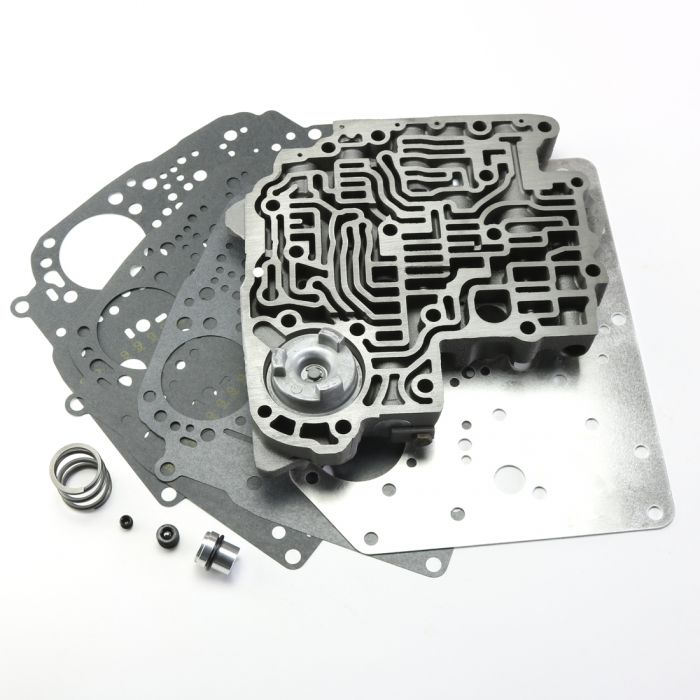In a manual transmission, the gears are changed by pushing in the clutch and manually shifting with a gear shifter. On the other hand, in an automatic transmission, the torque converter acts as the clutch, and the valve body is responsible for changing the gears.
The valve body in an automatic transmission contains several valves that serve specific functions. One of these valves is the manual valve, which is connected to the manual lever on the side of the transmission. The manual valve directs the flow of fluid within the transmission to provide the correct operation for the selected gear range.
So, what exactly is a manual valve body? A manual valve body is a modified version of an automatic valve body that allows for complete manual control over the transmission’s gears. With a manual valve body, the driver can shift gears instantly, without any overlap between shifts. This feature helps to extend the life of the clutches, as there is no slippage or unnecessary wear during gear changes.
While an automatic valve body allows for automatic shifting based on speed and throttle input, a manual valve body ensures that the gear selected by the driver is the gear the transmission remains in until the driver decides to shift.

Credit: www.sonnax.com
The Benefits of a Manual Valve Body
There are several benefits to using a manual valve body:
- Instant Shifting: With a manual valve body, the transmission shifts instantly without any delay or overlap between shifts. This allows for faster and more precise gear changes.
- Extended Clutch Life: The instantaneous shifting of a manual valve body helps to reduce clutch slippage and wear, resulting in an extended clutch lifespan.
- Control: A manual valve body gives the driver complete control over the transmission, allowing for optimal gear selection in various driving scenarios.
- Performance: For racing applications, a manual valve body provides greater control over the transmission, enabling the driver to achieve optimal performance on the track.
Manual Valve Body vs. Automatic Valve Body
The main difference between a manual valve body and an automatic valve body lies in the control over gear selection. With a manual valve body, the gear selected by the driver remains engaged until another gear is manually selected. In contrast, an automatic valve body shifts gears automatically based on speed and throttle input.
For street driving, an automatic valve body offers convenience by automatically shifting gears, eliminating the need for manual input. However, if you prefer the control and precise shifting of a manual transmission, a manual valve body is the way to go.
In racing applications, a manual valve body is favored due to the ability to have complete control over gear selection. This allows the driver to optimize acceleration and performance on the track.
Frequently Asked Questions On What Is A Manual Valve Body
What Is The Difference Between A Manual And Automatic Valve Body?
A manual valve body requires the driver to manually change gears using the gear shifter, while an automatic valve body uses a torque converter and a valve body to change gears automatically. Manual valve bodies provide instant and precise shifts, saving clutches.
Automatic valve bodies shift gears without driver input.
Is A Manual Valve Body Worth It?
Yes, a manual valve body is worth it. It offers benefits over an automatic valve body by enabling instant shifts without any overlap, which saves clutches. With a manual valve body, you can have full control over the gears like a manual transmission.
These valve bodies provide quicker shift timing and the ability to run higher line pressures.
What Is The Manual Valve On A Transmission?
The manual valve on a transmission is connected to the manual lever on the side of the transmission. It directs the flow of fluid within the transmission to provide the correct operation for the selected gear range. In a manual transmission, you manually change gears using the gear shifter, while in an automatic transmission, the valve body changes gears based on input from the torque converter.
A manual valve body allows for instant shifts without any overlap, which can benefit the transmission’s clutches.
Do You Need A Manual Valve Body For A Ratchet Shifter?
No, you do not need a manual valve body for a ratchet shifter. The ratchet shifter works independently of the valve body. The manual valve body is used to manually control the gear shifts in an automatic transmission, but with a ratchet shifter, the gears are selected directly by the shifter.
What Is A Manual Valve Body And How Does It Work?
A manual valve body is a component in an automatic transmission that allows the driver to manually control the shifting of gears. It works by directing fluid flow within the transmission to provide the correct gear range for the selected gear.
Conclusion
A manual valve body is a modified version of an automatic valve body that provides complete manual control over the gears in an automatic transmission. With a manual valve body, the driver has instant and precise control over gear changes, resulting in extended clutch life and improved performance.
Whether for street driving or racing applications, a manual valve body can enhance the driving experience and provide greater control over the transmission.






